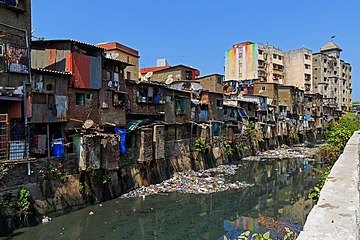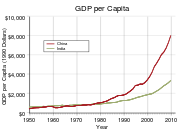Dieses Wiki, das alte(!) Projektwiki (projektwiki.zum.de)
wird demnächst gelöscht.
Bitte sichere Deine Inhalte zeitnah,
wenn Du sie weiter verwenden möchtest.
Gerne kannst Du natürlich weiterarbeiten
im neuen Projektwiki (projekte.zum.de).Poverty in India: Unterschied zwischen den Versionen
| Zeile 21: | Zeile 21: | ||
== Uprising industry in India == | == Uprising industry in India == | ||
India has one the fastest growing economies in the world. In 2017 India had a GDP ([https://en.wikipedia.org/wiki/Gross_domestic_product Gross domestic product]) grwoth rate of 6.7%<ref>Data for India by the "Internation Monetary Fund (IMF)": https://www.imf.org/en/Countries/IND, last accessed 16.01.2019</ref> (still increasing), while Germany had a growth rate of 2.5%<ref>Data for Germany by the "Internation Monetary Fund (IMF)": https://www.imf.org/en/Countries/DEU , last accessed 16.01.2019</ref> (aim: continual and appropriate economic growth (StabG)<ref>"Stabilitäts- und Wachstumsgesetz (StabG)" - Law ain furtherance of economic growth [...]: http://www.gesetze-im-internet.de/stabg/ (german), last accessed 16.01.2019</ref>. | India has one the fastest growing economies in the world. In 2017 India had a GDP ([https://en.wikipedia.org/wiki/Gross_domestic_product Gross domestic product]) grwoth rate of 6.7%<ref>Data for India by the "Internation Monetary Fund (IMF)": https://www.imf.org/en/Countries/IND, last accessed 16.01.2019</ref> (still increasing), while Germany had a growth rate of 2.5%<ref>Data for Germany by the "Internation Monetary Fund (IMF)": https://www.imf.org/en/Countries/DEU , last accessed 16.01.2019</ref> (aim: continual and appropriate economic growth (StabG)<ref>"Stabilitäts- und Wachstumsgesetz (StabG)" - Law ain furtherance of economic growth [...]: http://www.gesetze-im-internet.de/stabg/ (german), last accessed 16.01.2019</ref>. | ||
| + | [[File:GDP per capita of China and India.svg|thumb|GDP per capita of China and India]] | ||
The economic progress also has an influence on the national prosperity of the country. The labour force increased and also the employmentrates in "higher" paied jobs did: The rate of employees in wage employement increased by approximatly 8% in the period of 1993 untill 2012<ref>India Wage Report 2018 by the "International Labour Organization (ILO)": https://www.ilo.org/wcmsp5/groups/public/---asia/---ro-bangkok/---sro-new_delhi/documents/publication/wcms_638305.pdf</ref> | The economic progress also has an influence on the national prosperity of the country. The labour force increased and also the employmentrates in "higher" paied jobs did: The rate of employees in wage employement increased by approximatly 8% in the period of 1993 untill 2012<ref>India Wage Report 2018 by the "International Labour Organization (ILO)": https://www.ilo.org/wcmsp5/groups/public/---asia/---ro-bangkok/---sro-new_delhi/documents/publication/wcms_638305.pdf</ref> | ||
Version vom 16. Januar 2019, 21:43 Uhr
Despite of remarkable economic growth India is still one of the poorest countries of the world. India is also one of the biggest countries in the world with a population of 1.35 billion[1] (January 2019) and more than 13% live with $1.90 a day[2]
Inhaltsverzeichnis |
History and economical progress
The number of people living in extreme poverty has changed quickly in years past. According to the World bank more than 90 million has escaped extreme poverty in the period between 2011/2012 and 2015. Also the townscapes in the urbanized regions have changed; the number of the poor population in cities has decreased as well.
| Poverty | Number of poor (million) | Rate (%) | Period |
|---|---|---|---|
| National Poverty Line | 273.1 | 21.9 | 2011 |
| International Poverty Line US $1.90 (2011 PPP) per day per capita | 175.7 | 13.4 | 2015 |
| Lower Middle Income Class Poverty Line US $3.20 (2011 PPP) per day per capita | 659.2 | 50.4 | 2015 |
| Upper Middle Income Class Poverty Line US $5.50 (2011 PPP) per day per capita | 1,077.0 | 82.3 | 2015 |
The "World Poverty Clock" predicts that untill the beginnig of the year 2020 less than 3% of the total population will live in extreme poverty (currently: 3.6% according to "World Poverty Clock")[3]
Uprising industry in India
India has one the fastest growing economies in the world. In 2017 India had a GDP (Gross domestic product) grwoth rate of 6.7%[4] (still increasing), while Germany had a growth rate of 2.5%[5] (aim: continual and appropriate economic growth (StabG)[6].
The economic progress also has an influence on the national prosperity of the country. The labour force increased and also the employmentrates in "higher" paied jobs did: The rate of employees in wage employement increased by approximatly 8% in the period of 1993 untill 2012[7]
After the second world war the primeminister Nehru developed a mixed economy system with a pooling of central governance (collectivism) and liberal elements. This partly furthered the economical progress but the heritage of the British colony had an influence too.
Impact of British imperialism
Poverty Prevalence
Living Expenses in India
Facts and data
Political problems
References
- ↑ Accoridng to recent data: http://www.indiaonlinepages.com/population/india-current-population.html
- ↑ 2,0 2,1 Accordind to poverty data of India by the World bank: http://povertydata.worldbank.org/poverty/country/IND
- ↑ "World Poverty Clock" by World Data Lab in Vienna: https://worldpoverty.io/, last accessed 16.01.2019
- ↑ Data for India by the "Internation Monetary Fund (IMF)": https://www.imf.org/en/Countries/IND, last accessed 16.01.2019
- ↑ Data for Germany by the "Internation Monetary Fund (IMF)": https://www.imf.org/en/Countries/DEU , last accessed 16.01.2019
- ↑ "Stabilitäts- und Wachstumsgesetz (StabG)" - Law ain furtherance of economic growth [...]: http://www.gesetze-im-internet.de/stabg/ (german), last accessed 16.01.2019
- ↑ India Wage Report 2018 by the "International Labour Organization (ILO)": https://www.ilo.org/wcmsp5/groups/public/---asia/---ro-bangkok/---sro-new_delhi/documents/publication/wcms_638305.pdf



